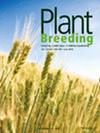卡布利鹰嘴豆(Cicer arietinum L.)基因型的抗虫害与微营养的结合
IF 1.8
4区 农林科学
Q2 AGRONOMY
引用次数: 0
摘要
豆科鹰嘴豆是蛋白质的良好来源,但其产量潜力经常受到生物胁迫的限制,主要是豆荚螟(Helicoverpa armigera)。为了发展寄主植物的抗性,最大限度地减少豆荚螟造成的损失,我们用五种具有抗豆荚螟所需性状的卡布利亲本进行杂交,产生了 10 个杂交种,并对这些杂交种与豆荚螟和营养相关的性状进行了分析。根据相关性研究发现,毛状体密度与酚含量呈正相关,但这两个性状都与受损种子数量呈负相关。因此,根据酚含量、毛状体密度、受损种子数量和田间评分确定了耐受性基因型。在亲本中,发现 ICC 12197 在产量和对钻心虫的耐受性方面更优越,除铁含量较高外,还具有中等抗虫害易感等级。然而,在 ICC 11764 × ICC 14190 中,除了铁和锌含量较高外,酚含量和种子产量均较高,受损种子数量也较少。据观察,该特定组合的每个性状都有好的组合和差的组合。同一杂交组合在酚含量、毛状体密度、受损种子数和种子产量方面也表现出明显的标准异交。此外,σ2 GCA 与 σ2 SCA 之比显示,在控制酚含量、毛状体密度、受损种子数以及铁和锌含量的表达方面,存在非加性基因作用。因此,育种者可在进一步的分离世代中,利用理想的杂交选择,重点培育酚含量、毛状体密度、铁和锌含量以及产量相关性状,同时减少每株受损种子的数量,以集中培育抗豆荚螟的高产卡布利基因型,防治微量营养素缺乏症。本文章由计算机程序翻译,如有差异,请以英文原文为准。
Integrating Antixenosis Against Helicoverpa armigera (Lepidoptera: Noctuidae) and Micronutrition in Kabuli Chickpea (Cicer arietinum L.) Genotypes
The leguminous chickpea is a good source of protein, but its yield potential is frequently constrained by biotic stresses, primarily Helicoverpa armigera , a major havoc for cultivation of the crop. To develop host plant resistance for minimizing the losses due to the pod borer, five kabuli parents with desired traits for pod borer tolerance were crossed in diallel mating design to produce 10 crosses which were analysed for traits related to pod borer and nutrition. Based on correlation studies, trichome density was found positively correlated with phenol content, but both the traits were negatively associated with number of damaged seeds. Therefore, the tolerant genotypes were identified on the basis of phenol content, trichome density, number of damaged seeds and field rating. Among parents ICC 12197 was found superior in terms of yield and borer tolerance features with an intermediate pest resistance susceptible rating in addition to higher Fe content. However, significant sca effects for higher phenol content and seed yield in ICC 11764 × ICC 14190 were recorded with reduced number of damaged seeds in addition to higher Fe and Zn content. It was observed that the specific combination involved good and poor combiners for each trait. The same cross also showed significant standard heterosis in desirable direction for phenol content, trichome density, number of damaged seeds and seed yield. Additionally, the ratio of σ 2 GCA to σ 2 SCA revealed nonadditive gene action in controlling the expression of phenol content, trichome density, number of damaged seeds and Fe and Zn content. Thus, breeder may focus efforts on desirable cross utilizing selection in further segregating generations for higher phenol content, trichome density and Fe and Zn content in addition to yield‐related traits while lesser number of damaged seeds per plant to concentrate for development of pod borer resilient high yielding kabuli genotypes to combat micronutrient deficiency.
求助全文
通过发布文献求助,成功后即可免费获取论文全文。
去求助
来源期刊

Plant Breeding
农林科学-农艺学
CiteScore
4.40
自引率
5.00%
发文量
74
审稿时长
3.0 months
期刊介绍:
PLANT BREEDING publishes full-length original manuscripts and review articles on all aspects of plant improvement, breeding methodologies, and genetics to include qualitative and quantitative inheritance and genomics of major crop species. PLANT BREEDING provides readers with cutting-edge information on use of molecular techniques and genomics as they relate to improving gain from selection. Since its subject matter embraces all aspects of crop improvement, its content is sought after by both industry and academia. Fields of interest: Genetics of cultivated plants as well as research in practical plant breeding.
 求助内容:
求助内容: 应助结果提醒方式:
应助结果提醒方式:


